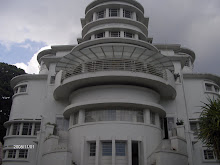Name : Rini Triani .
Student Number : 0807327
Class : Dik-3B
Periods of English Literature
` Many Historians have separated English literature into periods for make it easier to understand. The names, number or dates of the periods sometimes are different. For the definition itself, English Literature refers to literature works written in English language (Wikipedia.com). English literature is as varied as the dialects and varieties of English spoken countries around the world.
Here are the sequences of the periods of English literature with each brief explanation:
a) Old English (Anglo-Saxon) Period (5th-11th C)
• The first works literature in English which is brought orally tradition.
• Beowulf is the greatest of Germanic epics.
• The Epic poems were very popular and have survived until nowadays.
• Appeared from the invasion of Viking by Germanic
• Most of literary works are anonymous (The Seafarer, The Wanderer
• Figures: Anonymous
• Beowulf, Caedmon’s hymn, Cynewulf, The Battle of Maldon
b) Middle English Period (12th-15th C)
• “The Modern English” was taken as the standard literary language.
• The French dialect influenced the Non-Latin literature
• It began from religious writings, and then secular literature become more popular in the 14th C.
• Figures: Chaucer, John Gower, William Langlan, Thomas Malory.
• Examples: Guillaume de Lorris, Jean de Meun’s, Roman de la Rose, Piers Plowman (religious and satirical poem), Morte d’Arthur (the romance prose).
c) The Renaissance (early Modern) Period (16th-17th C)
• The works were produced ender Queen Elizabeth I and King James I.
• The other names of this term are Elizabethan Age and Jacobean Age affected by politic rules.
• The Commonwealth also known as Restoration or Baroque
• Edmund Spenser,Sir Philip Sidney,William ShakespeareJohn Milton
• Examples: The Book of Common prayer, Faerie Queene (epic),Eupheus (romance drama), Arcadia, Court Masque (drama), Paradise Lost and Paradise regained ( political and religious epics)
d) Augustan Period (18th C)
• This period mostly political, an age of scandal.
• Novels was a new literary and became one of the most productive genres of modern literary history.
• Figures: Alexander Pope, James Thomson, Edward Young, Joseph Addison, Jonathan Swift
• Examples: Rape of the Lock, The Dunciad, The season, Night Thoughts, The Tatler, The Spectator
e) Romanticism Period (Firs half of 19th C)
• Beginning a new period which nature and individual.
• It reacted political changes in Europe and America.
• Romantic poems shown a new emotionalism and introspection.
• Figures: William Wordsworth, Samuel Taylor Coleridge, William Blake, Percy Bysshe Shelley, Mary Shelley, John Keats, Jane Austen.
• Examples: Lyrical ballads, Rime of the Ancient Mariner, Ode to the West Wine, Ode on a Grecian Urn, Pride and Prejudice
f) Victorian Age (2nd half of 19th C)
• Novel became the leader of English literature described reality and the truth of social life with Drama as a famous work.
• Figures: William M.Thackeray, Bronte sister, George Elliot, Charles Dicken.
• Examples: Vanity fair, Realist novel, Pickwick Papers
g) Modernism (1st to 2nd World War)
• As a reaction to the Realism with objective truth.
• Modernism focused on innovative narrative methods influenced by psychoanalysis and cultural-historical phenomena.
• The aspirators of this period were Karl Marx and Sigmund Freud.
• Figures: James Joyce, Virginia Wolf, William Faulkner, Ezra Pound.
• Examples: Dubliners, Ulysses
h) Postmodernism (1960s and 1970s)
• To describe certain tendencies in post-World War II.
• Figures: Thomas Pynchon’s
• Examples: The Crying of Lot 49
REFERENCES:
1. [Online]. "http://en.wikipedia.org/wiki/PeriodsofEnglishLiterature"[September,9 2009]
2. Klarer, Mario. (1998). An Introduction to Literary. London. Roudledge.
Jumat, 02 Oktober 2009
Langganan:
Posting Komentar (Atom)


Tidak ada komentar:
Posting Komentar